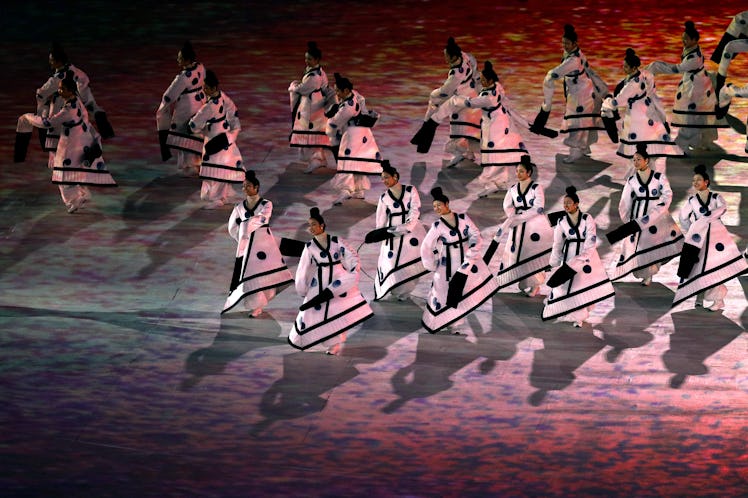
The Meaning Of The Dancers’ Dresses In The 2018 Olympics Opening Ceremony Is So Beautiful
It's here! The 2018 Winter Games have officially kicked off with a stunning event in PyeongChang that gorgeously encapsulates various aspects of Korean culture. The meaning of the dancers’ dresses in the 2018 Olympics opening ceremony speaks to the country's rich sartorial history, as different colors and silhouettes are reserved for various types of events.
To preface this piece, I want to say that I am in no way, shape, or form and expert on South Korean culture or fashion. However, thanks to the wonderful thing that is the internet, I've done some deep diving into Korea's cultural symbolism and feel like the conclusions I've drawn about the dancer's said dresses are (hopefully) pretty accurate.
As is custom with all Olympics opening ceremonies, this year's spectacle was deeply rooted in the traditions of its host country, which is, of course, Korea. From its puppets and dancers to the sets and performers, everything was a beautiful testament to the nation's rich culture. (It was seriously one of the most gorgeous ceremonies I can remember ever seeing — the special effects and performers were incredible.) The white dresses with dark, inky spots were especially eye-catching, for their gorgeous silhouettes and starkly contrasting color palette.
In Korean culture, white is the most commonly used color. According to Our Everyday Life, "Koreans were sometimes referred to as 'the white clad people,'" as white largely composed their daily attire in the 19th century. Symbolizing purity, innocence, peace, and patriotism, it's easy to understand why the color would be heavily used within the opening ceremony. (North and South Korea marched together under the unified Korean flag for the first time in 12 years and wore white uniforms; many other dancers featured in performance section were also clothed in traditional Hanboks in the hue; many items within the set and used as props were white.)
When used in conjunction with black, the coupling of the colors also represents a harmonic balance and the philosophy of dual forces that's present within Eastern culture. This philosophy is called um-yang in Korean, while in Chinese it's yin-yang. The idea behind it is that life has both good and bad, dark and light aspects to it, which allow us to truly appreciate each force on its own. If you look at the dancer's dresses, they almost look like wearable versions of the known yin-yang symbol. If you look at the Korean flag, it's central circle (the Tae-Geuk) takes on the shape of the symbol as well, just sans dots.
In regard to the silhouette of the dress, the most striking aspects to it are it's slanted hemline and extra long sleeves. After doing some research into traditional Korean attire, it appears that garments with extended sleeves are worn for a number of traditional dances. If you watched the opening ceremony, it's easy to see why. The sleeves flutter and wave as the dancers swirl and move, and they give the performance an incredibly dramatic effect.
I wasn't able to pinpoint exactly which type of dance was being performed, as within each subsection of Korean dance — including ritual dance, folk dance, court dance, et cetera — are even more specific dances. For example, Seungmu is the name of a folk dance traditionally performed by Korean monks. Performers wear a long sleeve called gasa and a white hood called gokkal when executing the dance. Gainjeonmokdan is a type of court dance performed by women and while its associated attire also features extended sleeves, they're always vibrant and colorful. The list of such dances and variations of long-sleeved dance attire goes on.
In short, the black and white dresses play beautiful homage to Korean culture. I'm sure a book could be written about where their silhouette was derived from, what their design elements mean, and how their pattern plays into Korean philosophies, symbolism, and tradition.
After my slight research into Korean dress, I am honestly eager to learn more about it and its vastly complex beauty. This is why global events like the Olympics are so important; they prompt individuals to become curious about other places, people, and ideas, and provide a unified event that we can all come together over.